Menu 2024-25 2023-24 2022-23 2021-22 2020-21 2019-20 2018-19
2024-25
i. Quantum Entanglement Surveying Technology, Corbin Hawkes, 4/24/2025
2023-24
-
Geometric-optical Approximation in Black Hole Quasinormal Modes and its Connection with Light Echoes, Wei-Liang Quan, University of São Paulo, August 30
-
The Cosmic Web: Novel Methods of Caustic Identification and Analysis, Michael Sitarz, University of Kansas, October 26
-
Navigating the Algebraic Classification of Spacetimes with the Weyl Tensor, David McNutt, The Arctic University of Norway, November
-
Accretion of Vlasov Gas into a Kerr Black Hole, Adam Cieślik, Jagiellonian University, November 16
-
Physics of Pulsar Magnetospheres, Alexander Philippov, University of Maryland, Dec 5
-
Distinguishing Jordan and Einstein Frames in Gravity through Entanglement, Sumanta Chakraborty, Indian Association for the Cultivation of Science, Feb 1
-
Cosmological Magnetic Fields, Tanmay Vachaspati, Arizona State University, Feb 6
-
The Phase Diagram of Einstein-Weyl Gravity, Samuele Silveravalle, Trento University, Feb 15
-
Metric-independence of Vacuum and Force-Free Electromagnetic Fields, Abraham Harte, Dublin City University, Feb 20
-
Static Spherically Symmetric Solutions in New General Relativity, Alexey Golovnev, Centre for Theoretical Physics, The British University in Egypt, Feb 22
-
Gravitational Repulsive Effects in 3D Regular Black Holes, Orlando Luongo, University of Camerino, March 7
-
Geodesic incompleteness of some popular regular black holes, Tian Zhou, University of Groningen, March 14
-
Conformally Covariant Characterization of the Kerr Conformal Structure, Alfonso García-Parrado, Universidad de Cordoba, March 19
-
Splitting Spacetime: A Systematic Analysis of Foliation Dependence in Cosmic Averaging, Pierre Mourier, Universitat de les Illes Balears, Asta Heinesen, Niels Bohr Institute, April 11
-
Quantum Field Theory in Non-Smooth Spacetimes, Yafet Sanchez, University of Genova, Italy, April 11
2022-23
- Particle, Wave, Field, String: the emergence of strings & holography in theoretical
physics
Ben Burrington, Hofstra University, September 21 - Life Cycle of Stars
Justin Bankert, Troy University, September 30 - Light Pollution at Home in the South: How it Affects Us and What We Can Do
Michelle Wooten, UAB, October 5 - How Galaxies are Shaped by Supermassive Black Hole Winds
Mitchell Revalski, Space Telescope Science Institute, October 21 - Galactic Archeology: Using Stellar Fossils to Understand the History of our Galaxy
Ilija Medan, Georgia State University, Feb 3 - One Big Picture of M Dwarf Binary Star Orbits
Eliot Vrijmoet, GSU, March 7 - The Force-Free Electromagnetic Field in Kerr Geometry: The Search for Analytic Solutions
Govind Menon, APS Minneapolis, April 16 - On the Tully-Fisher Relation for AGN Host Galaxies
Justin Robinson, Mitchell Revalski, Veronica Lahue, Thomas Kay, Mira Menon, AAS 2023, Albuquerque, June 9 - Relativistic Jets, dark Matter and Structure Formation
Rakshak Adhikari, University of Kansas, June 28
2021-22
- Self-organized Plasma Structures
James Allen, Troy University, November 8 - Cosmology of Flavor-mixed Cold Dark Matter
Rakshak Adhikari, University of Kansas, November 10
2020-21
- The Chemistry and Toxicology of Vaping
Tori Colvin, Oregon State University, March 17
2019-20
- Molecules Illuminated from Within
Allen Landers, Auburn University, November 21 - Electricity and Magnetism with Boy Scouts
Quratulann Ijaz - IRES in Prague
Rachid Bowles - Solar System and Beyond – Discovering the Secrets of the Universe
John Weis, Marshall Space Flight Center, October 23
2018-19
The Effect of Projectile Mass on Ballistic Pendulum Displacement
The relationship between projectile mass and final displacement height for the pendulum arm in a ballistic pendulum is tested. To do this metal projectile balls of five different masses that undergo a perfectly inelastic collision with the pendulum arm, and then the total vertical displacement of the arm is measured. The arm's maximum displacement height increases monotonically for balls of mass less than the effective mass of the pendulum arm, in good agreement with a model based on linear momentum conservation during collision and energy conservation both during the motion of the arm after the collision and (separately) during firing sequence of the ball.
Dr. Justin Bankert
Astrophysical Binary Systems
Monday, May, 2:00-3:00 p.m.
MSCX -Room 1114
In this presentation, I describe the nature of accretion disks. Specifically, I describe the formation of accretion disks and the processes which occur within a disk that allow material to move inward towards central accretion. I also discuss the nature of astrophysical binary systems and their importance on a variety of mass and size scales. Combining these two topics, I discuss my thesis work, which involved studying the effect of circumbinary accretion disks on the evolution of a central binary system. Finally, I talk about some of the projects that I have worked on with undergraduate students in my time at Angelo State University.
John Weis
EPD Specialist
Department of Aerospace Engineering
NASA Marshall Space Flight Center
Tuesday, March 26, 2019
4:00-5:00 p.m.
MSCX -Room 114


Photograph by Dr. Maurice Clark
John Weis
EPD Specialist
Department of Aerospace Engineering
NASA Marshall Space Flight Center
Tuesday, December 4
3:00-4:00 p.m.
MSCX -Room 114

Have you been wondering what NASA is up to? Join NASA Education specialist John Weis as he discusses NASA's plans to send people back to the Moon in the next few years and then on to Mars before 2040. The presentation will focus on transportation systems including the Space Launch System, Orion Crew Capsule and Exploration Ground Systems.
Saturday, October 27
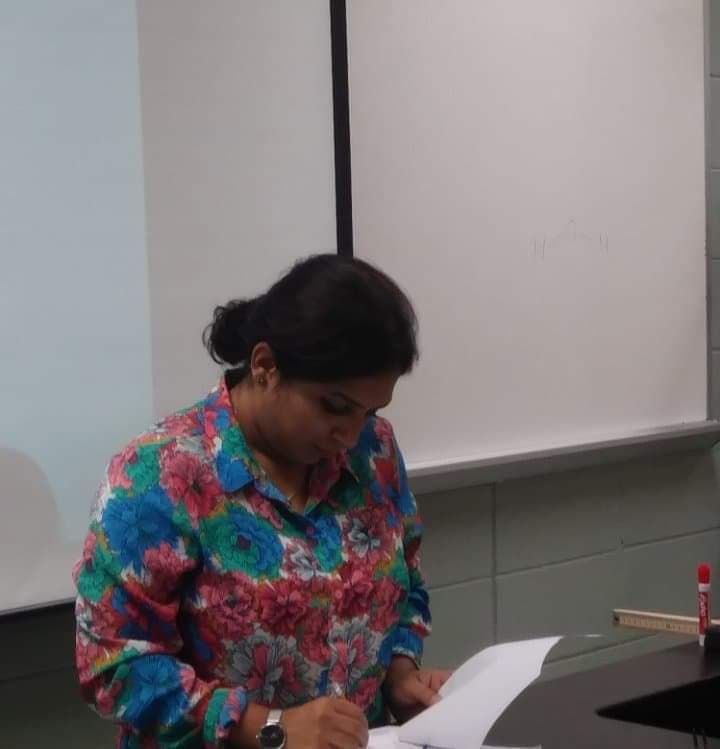
Dr. Qurat Ul Ann Ijaz led the class that introduced to the scouts, the basics of static and current electricity, basic magnetism and the connection between the two. The students also learned about basic safety measures to be exercised when dealing with electrical equipment.
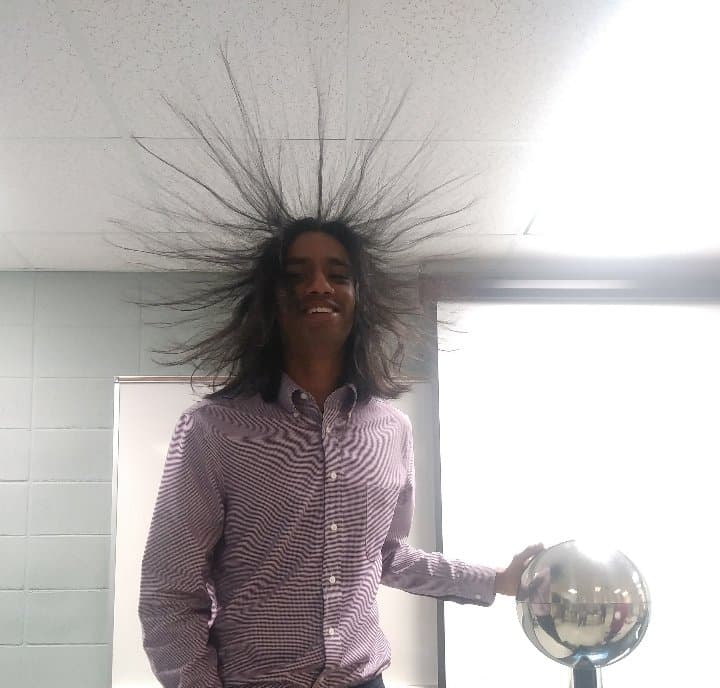
Rakshak explained the basics of magnetic field, their origin and then performed a demonstration with the Van De Graff generator.
Dr. Michael J. Bozack
NSF Center for Advanced Vehicle Electronics and Extreme Environment Electronics (CAVE3)
Auburn University Auburn, AL 36849
Wednesday, October 17
3:00-4:00 p.m.
MSCX -Room 114

Whiskers are single crystal electrically conductive eruptions that spontaneously grow from the surface of plated films. They have resulted in billions of dollars of liability to electronic circuitry, particularly those which operate in extreme environments. Whiskers are problematic for electronic assemblies since they can breach components and create short circuits.
Wednesday, October 24
4:00-5:00 p.m.
MSCX -Room 214

Ty Naquin, a junior physics major and Computer Science minor, presented his research on "Drug Delivery Nanoparticles", a project he worked on as a REU student at Cleveland State University. He explained the reversible phase transition that he observed in the Elastin-like polypeptides (ELPs) which can be used to synthesize armed polymers with arms made up of ELPs. He talked about the different properties of such polymers under different conditions of temperature , pH and salt concentration he studied via dynamic light scattering and spectroscopy.
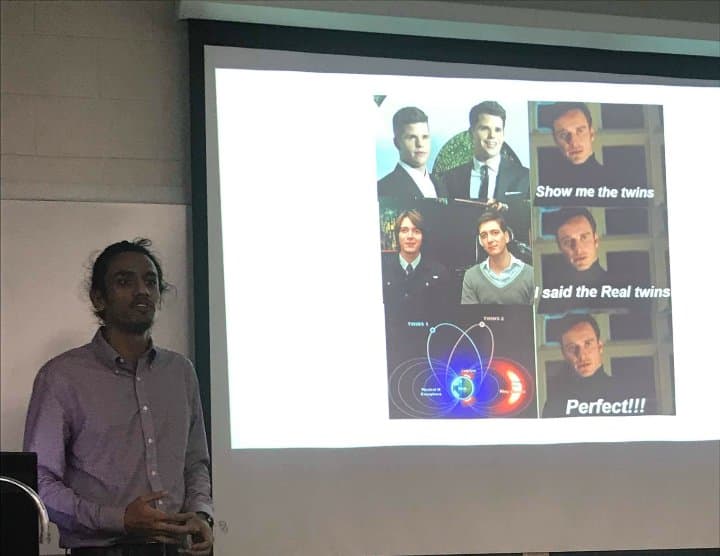
Rakshak Adhikari, a junior physics and mathematics major, presented his research on " Seeing the invisible: study of interactions of geomagnetic storms with earth's magnetosphere", his summer research project at Auburn university. He explained the dynamic nature of earth's magnetosphere, the properties of ring current and the importance of such a study. He talked about the satellite based NASA sensors that detected Energetic Neutral Atoms and the complex computational procedure that extracts the ion density from the observed data.
4:00-5:00 p.m.
MSCX -Room 214

Madelynn Lytle presented her research on Light Capture in Cone Photoreceptors using 2-photon stimulation that she worked on at the University of Alabama in Birmingham.

Donavan Ebersole presented his summer research on Measuring Viscosity using a Damped Harmonic Oscillator at Troy University in collaboration with Dr. James Sanders and Ty Naquin.
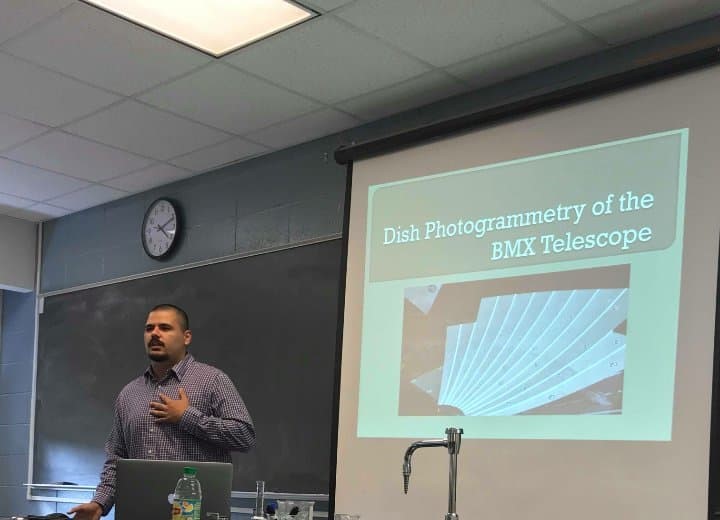
Sebastian Lee presented his research on Dish Photography of the BMX Telescope that he worked on this summer at the Brookhaven National Lab.
2017-2018
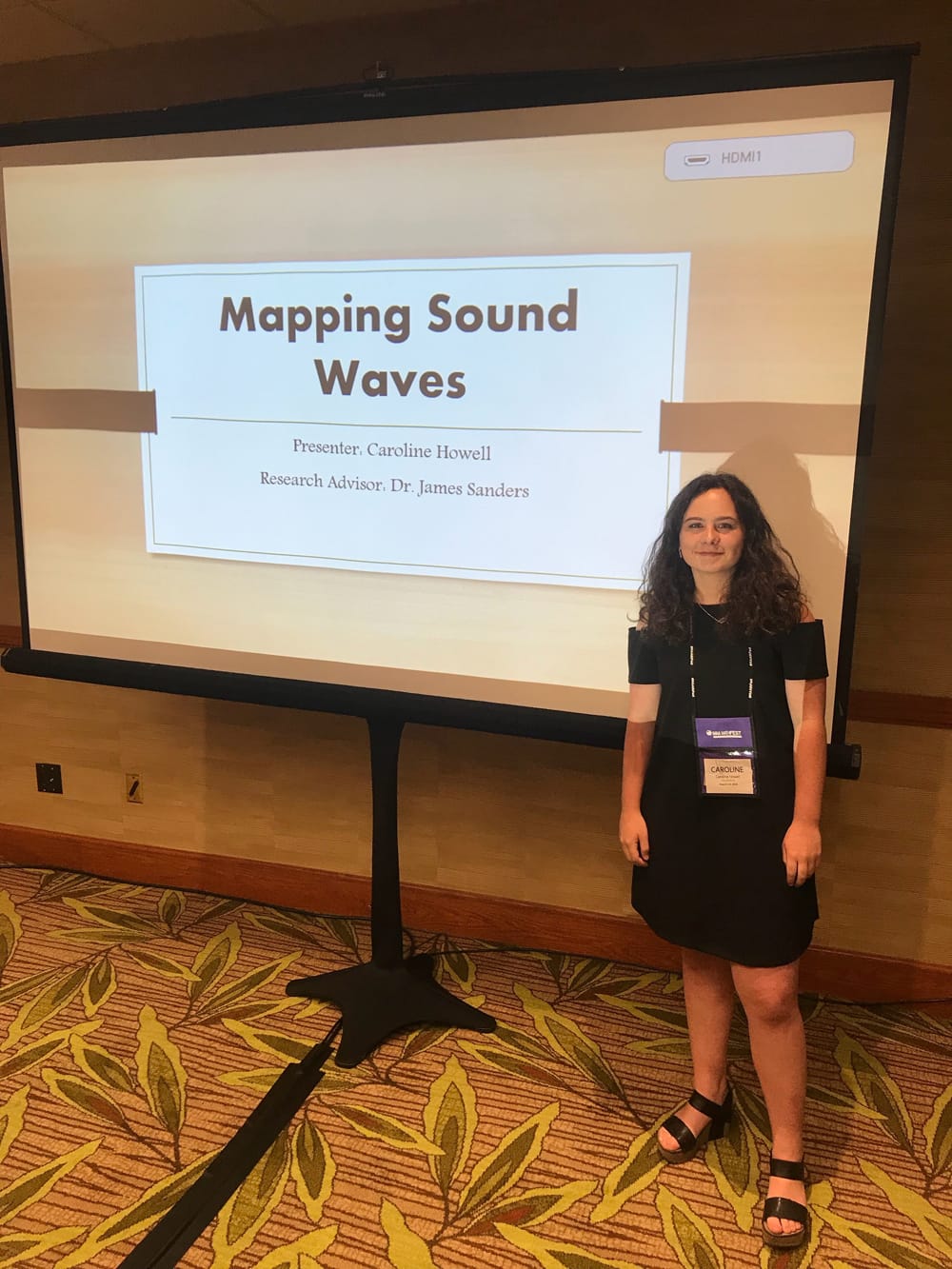
Caroline Howell was awarded the Student Speaker Award for her presentation on Mapping Sound Waves at the Pi Mu Epsilon (PME) Conference in Denver, Colorado. (Research Advisor: Dr. Sanders)

Rakshak Adhikari and Dr. Maurice Clark at the Society for Astronomical Sciences symposium on Telescope Science (Ontario, California)
Dr. Maurice Clark presented his paper titled "Nine new variable stars".
Rakshak Adhikari presented his paper titled " Modelling WUMa Eclipsing Binary Stars using Binary Maker 3.0".
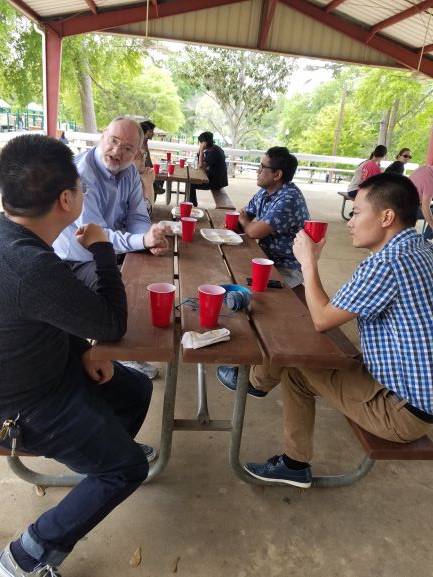
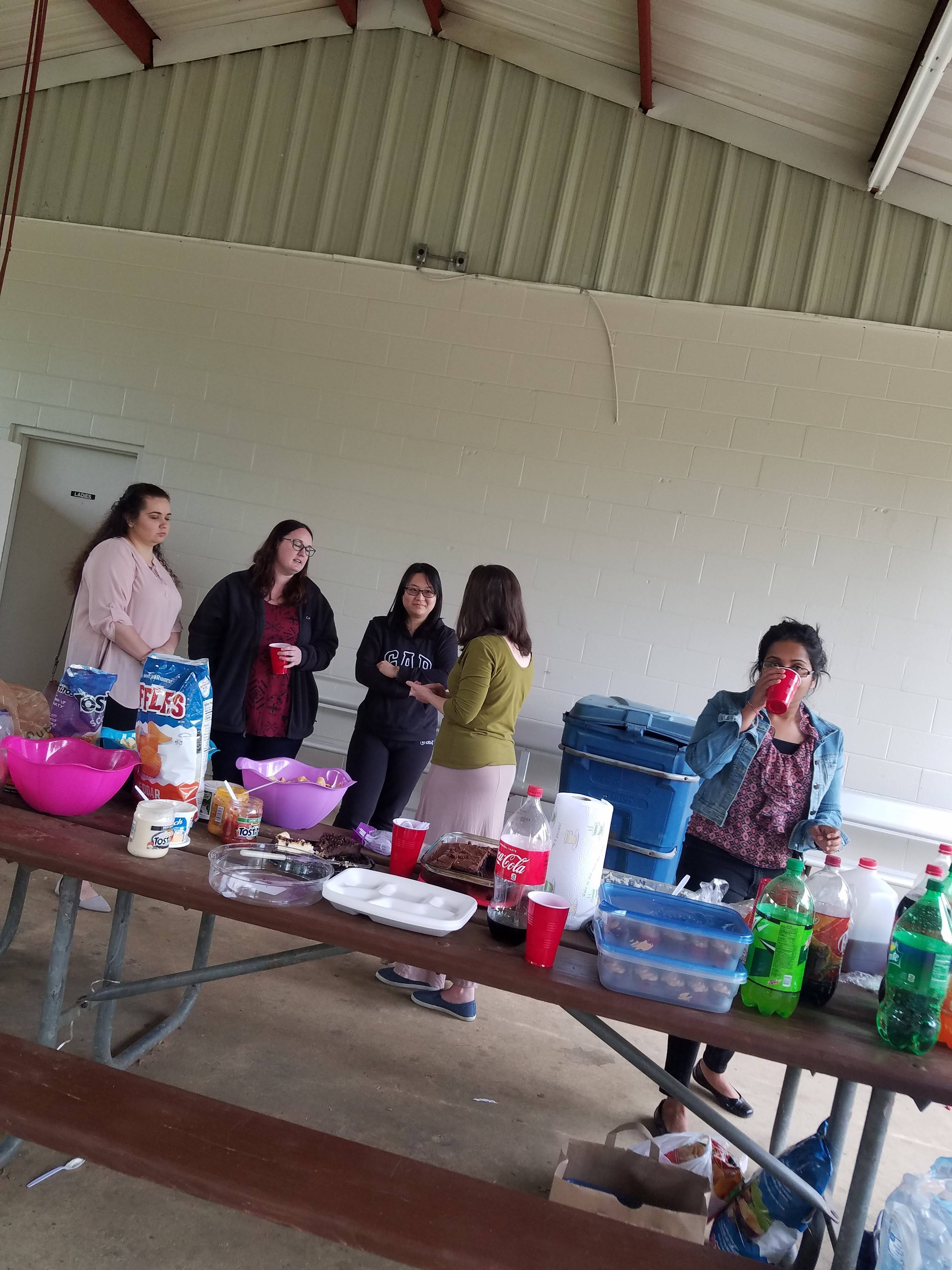
Murphree Park, 4/8/2018
Dr. Hassan Kesserwani (M.D)
Thursday, April 26
3:00-4:00 p.m.
MSCX -Room 114
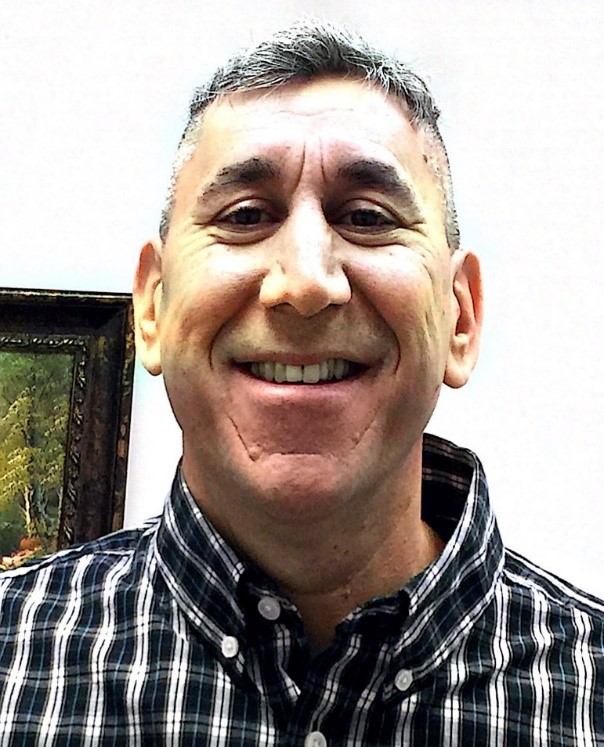
Dr. Hassan Kesserwani is a renowned neurologist and a practicing physician in Dothan, Al. Dr. Kesserwani is currently pursuing a Master's Degree in mathematics in his spare time. He will deliver a general audience talk that will introduce students to the mathematical formalism behind General Relativity.
John Weis
EPD Specialist
Department of Aerospace Engineering
NASA Marshall Space Flight Center
Tuesday, February 13
3:00-4:00 p.m.
MSCX -Room 114
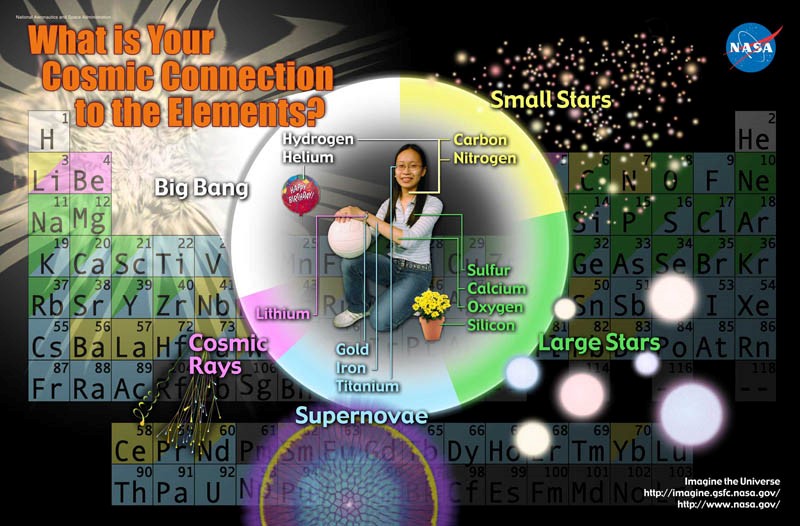
Have you ever wondered where we all came from? Join NASA Educator Professional Development Collaborative specialist John Weis and explore the linkage between the life cycle of stars and the elements of the periodic table.
John Weis
EPD Specialist
Department of Aerospace Engineering
NASA Marshall Space Flight Center
Wednesday, November 29
3:00-4:00 p.m.
MSCX -Room 114
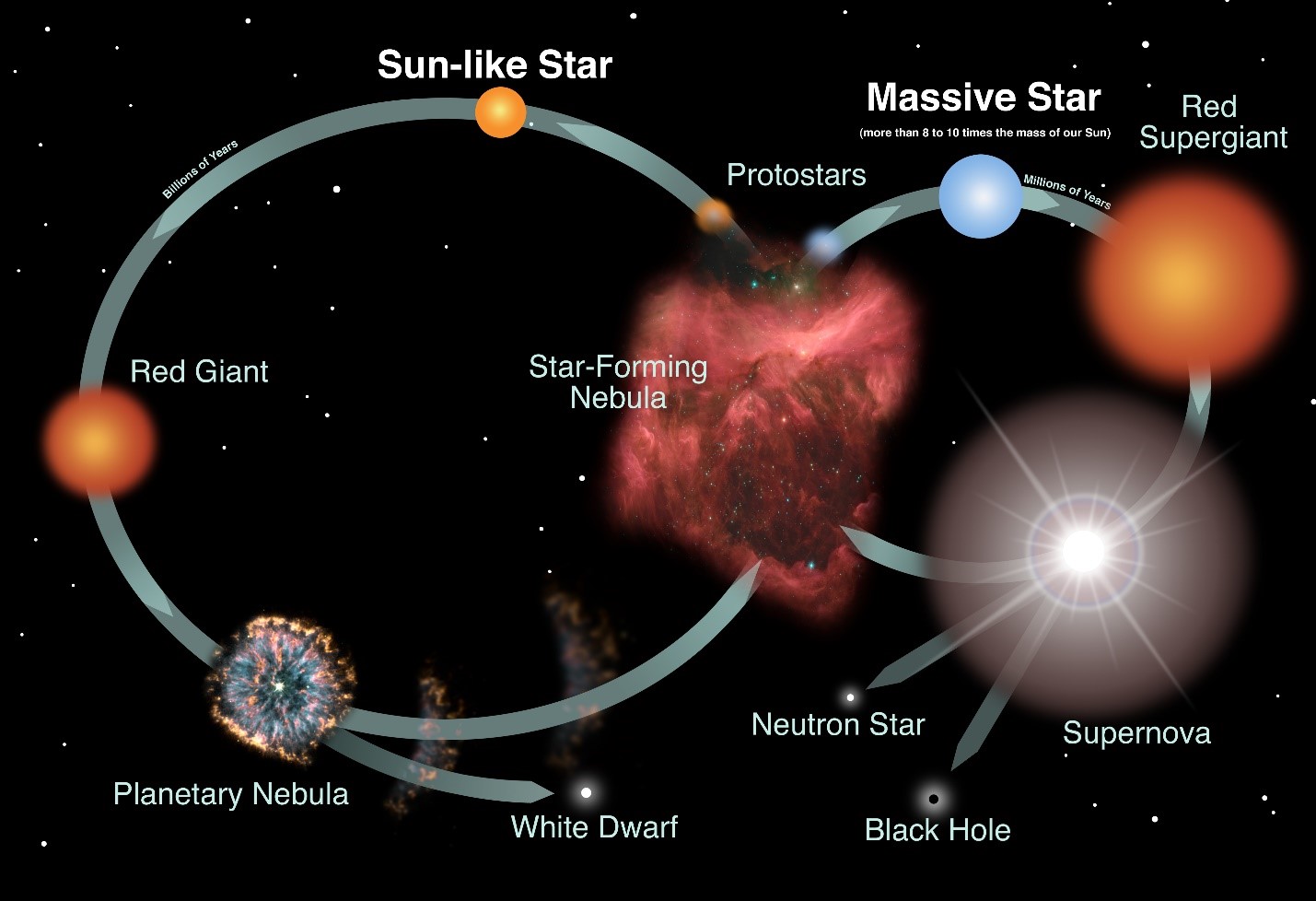
What happened after the Big Bang? Join NASA Educator Professional Development Collaborative specialist John Weis on a tour of the life cycle of stars of all sizes and temperatures.
Dr. Vrishank Raghav
Assistant Professor
Department of Aerospace Engineering
Auburn University
Wednesday, October 25
3:00-4:00 p.m.
MSCX -Room 114
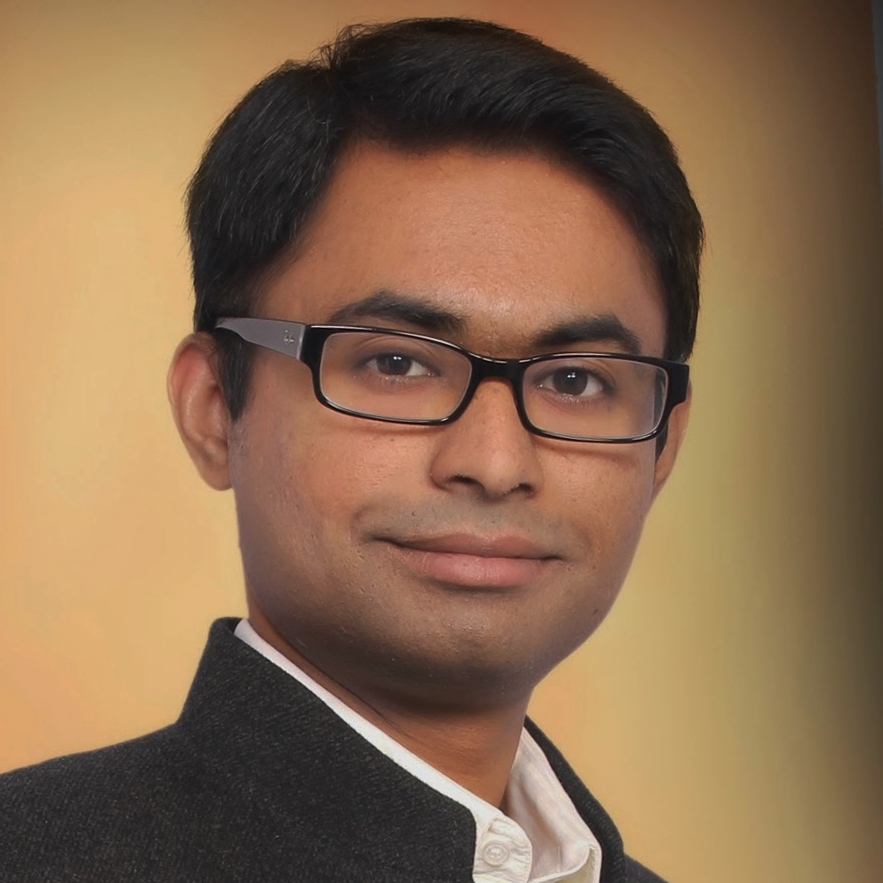
Unsteady flows are common in both engineering and biological applications. This talk
focusses on understanding the physics of unsteady flows across disciplines by using
experimental techniques. The primary focus is on unsteady flow occurring on helicopters
and wind turbines due to flow separation leading to dynamic-stall (DS) and on the
unsteady flow in the cardiovascular system. Results from recent experiments that capture
the significant effects of rotation using Stereoscopic Particle Image Velocimetry
will be presented. The talk will also discuss in detail some of the recent work on
understanding the fluid physics of unsteady flows in the human cardiovascular system.
Dr. Vrishank Raghav is an Assistant Professor in the Department of Aerospace Engineering at Auburn University. Previously he was an American Heart Association Postdoctoral Fellow at Georgia Institute of Technology, where his work was on understanding the effect of hemodynamics on the progression of congenital heart valve disease. Before diversifying into biological flows, he obtained his Ph.D. in the School of Aerospace Engineering at Georgia Tech in 2014. His dissertation was focused on understanding the three-dimensional nature of unsteady flow separation occurring on wind turbine and helicopter rotor blades and was chosen by Sigma-Xi, the Scientific Research Society as the 2015 Best Georgia Tech Ph.D. Thesis.
Richard Sizelove (Math Major)
(moderated by Dr. Govind Menon)
Fall Semester, every Tuesday at 2:00 p.m., Room 318
Student presentations moderated by Dr. Govind Menon
Fall Semester, every Tuesday at 1:00 p.m., Room 318
Dr. David Hilton
Associate Professor
Department of Physics
The University of Alabama at Birmingham
Tuesday, October 3
3:00-5:00 p.m.
MSCX -Room 114
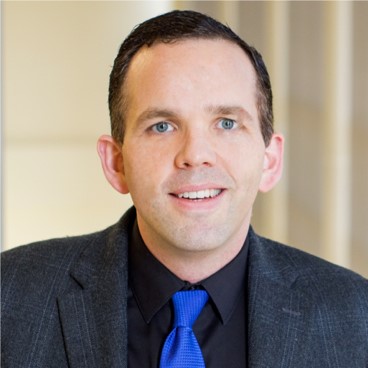
Two-dimensional materials have attracted significant interest recently as candidates
to replace silicon in microelectronics. In the past few years, there have been a number
of new monolayer materials systems that have attracted significant interest, including
graphene (monolayer carbon), silicine (monolayer silicon), germanene (monolayer germaium),
and stanene (monolayer tin), black and blue phosphorous, and dichalcogenicdes (MoS2,
MoSe2, WS2 and WSe2), among a rapidly growing list of materials. These materials,
however, are heavily disorder-dominated systems with measured electron mobility of
≪1000 cm2 V-1 s-1 that can be largely associated with the extrinsic properties (defects,
surface adsorption, and other lattice imperfections). The modulation doped gallium
arsenide two-dimensional electron gas has seen extensive study and the growth of high
quality samples with mobilities exceeding 106 cm2 V-1 s, which provides a model system
to study the electronic and optical properties of two-dimensional materials in the
“clean” limit.
Ultrafast spectroscopic techniques are a frequently employed and powerful technique
that is used to unravel complex and often competing processes in condensed matter
systems on a femtosecond time scale. These study a wide range of excitations over
the electromagnetic spectrum from the terahertz to the x-ray with subpicosecond time
resolution. These results will be needed for future electronics design in these materials.
In this talk, I will discuss our work using terahertz time-domain spectroscopy to
study Landau level populations and coherences in high mobility two-dimensional semiconducting
systems. We model our results using the Optical Bloch Equations to determine the dephasing
lifetime as a function of temperature and explain our low temperature results using
ionized impurity and bound interface charge scattering in the conducting layer. In
the second part of my talk, I will discuss our recent work to study these materials
in high magnetic field using the 25 Tesla Split-Florida Helix magnet at the National
High Magnetic Field Lab. Our results reveal a complex interplay between conventional
(electron transport) and complex (many-body) electronic interaction on an extremely
fast time scale.
This work has been funded by NSF CAREER (2DEG Materials Physics, DMR-1056827) and
the Department of Energy/Basic Energy Sciences (Instrument Development, DE-SC0012635).
Additional funding for graduate students working on these projects comes from the
Department of Education GAANN (P200A090143). A portion of this work was performed
at the National High Magnetic Field Laboratory, which is supported by National Science
Foundation Cooperative Agreement No. DMR-1157490 and the state of Florida. This work
was performed, in part, at the Center for Integrated Nanotechnologies, a U.S. Department
of Energy, Office of Basic Energy Sciences user facility.
After Dr. Hilton's talk, he is interested in talking to students with interest in
attending graduate school. In addition to recruiting for UAB's program, he has been
affiliated with a number of different programs in his career and would be willing
to talk about gradate school admission requirements, how to choose a school, what
to look for in a thesis advisor and project, and what future jobs are available.
Dave Hilton received B.S. (1997) and M.S. (1999) degrees in Optics from the University
of Rochester. He received a M.S. (2001) and Ph.D. (2002) in Applied Physics from Cornell
University. From 2002 to 2006, he was a postdoctoral researcher at Los Alamos National
Laboratory in New Mexico, where his research focus shifted to terahertz spectroscopy
of correlated electronic systems. From 2006 to 2007, he was a postdoctoral researcher
at Rice University, where his interests included the development of novel spectroscopic
measurement techniques for high-resolution spectroscopy in high magnetic fields. He
joined the faculty as Assistant Professor of Physics at the University of Alabama
at Birmingham and was promoted to Associate Professor in 2013. His research program
focuses on the study of insulator-to-metal phase transitions in transition metal oxides
and ultrafast investigations of high mobility 2DEGs and dichalcogenides.
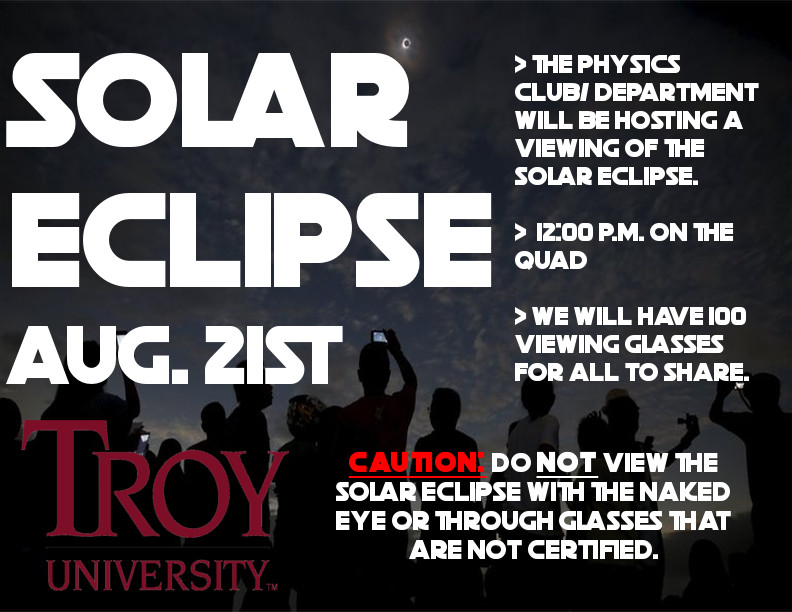

Photo by Dr. Maurice Clark

Al Allenback and friend


Dr. Bateman's Retirement Party
2016-2017
Dr. Maurice Clark
Thursday, April 27
4:00-5:00 p.m.
MSCX -Room 114
Astronomy is more than just "looking at stars". The universe is a giant laboratory that allows us to explore nature in conditions far more extreme than can be produced on Earth. It is the most fundamental of all sciences and the most all-encompassing. In addition, our understanding of the universe is expanding at an exponential rate. Yet astronomy is also the most democratic of sciences. Its beauty and its wonder are open to all, and not just the scientist using giant telescopes. Examples of research opportunities with modest equipment are presented as are important discoveries by non-scientists through Citizen Science projects.
John Weiss
NASA, Marshall Space Flight Center
Wednesday, April 19
4:00-5:00 p.m.
MSCX -Room 114
This presentation gives a brief overview of current events at NASA including current and near-term missions, new discoveries and long-term goals of the agency. Topics covered will include unmanned missions, human space flight, aeronautics research and their impacts on the standard of living in the United States.
Watch the presentation here.
Saturday, April 15
Back row (left to right): Joanna Campbell, Ty Naquin, Govind Menon, Andrew Crokett,
Pawan Khanal, Yogesh Niraula, Pawan Khatiwada, Bishal Niroula, Rakshak Adhikari, Aashish
Kafle
Front row (left to right): Aayush Nepal, Alex Brassington, Regan Bhatta, Nilotpal
Mukherjee
All day Tuesday, March 28
Location: TBA
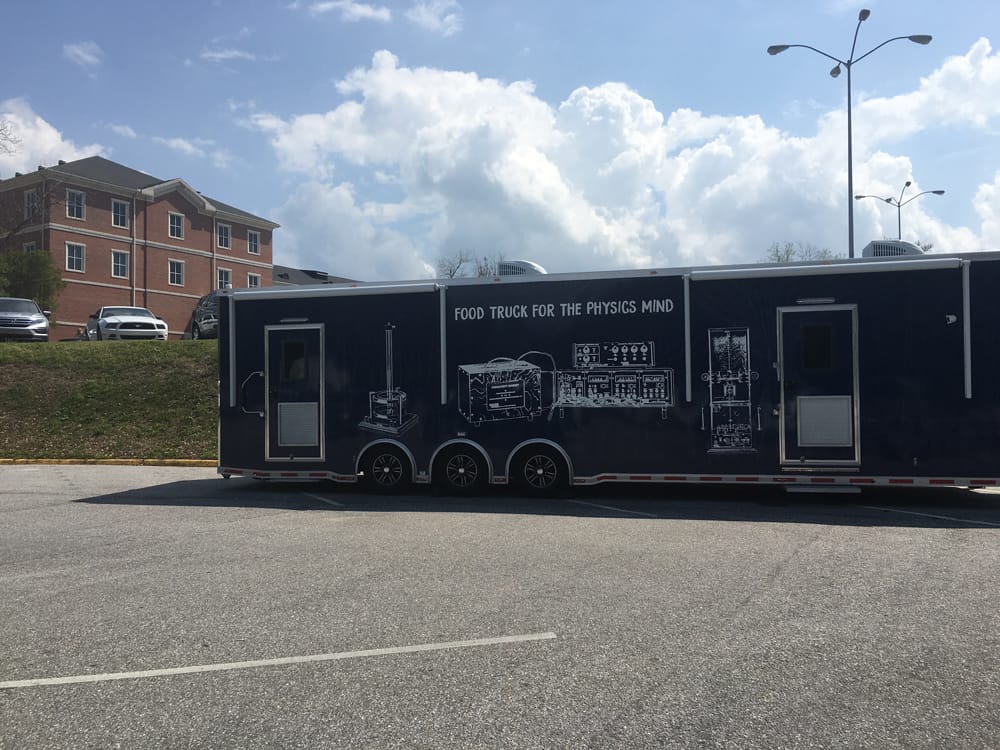
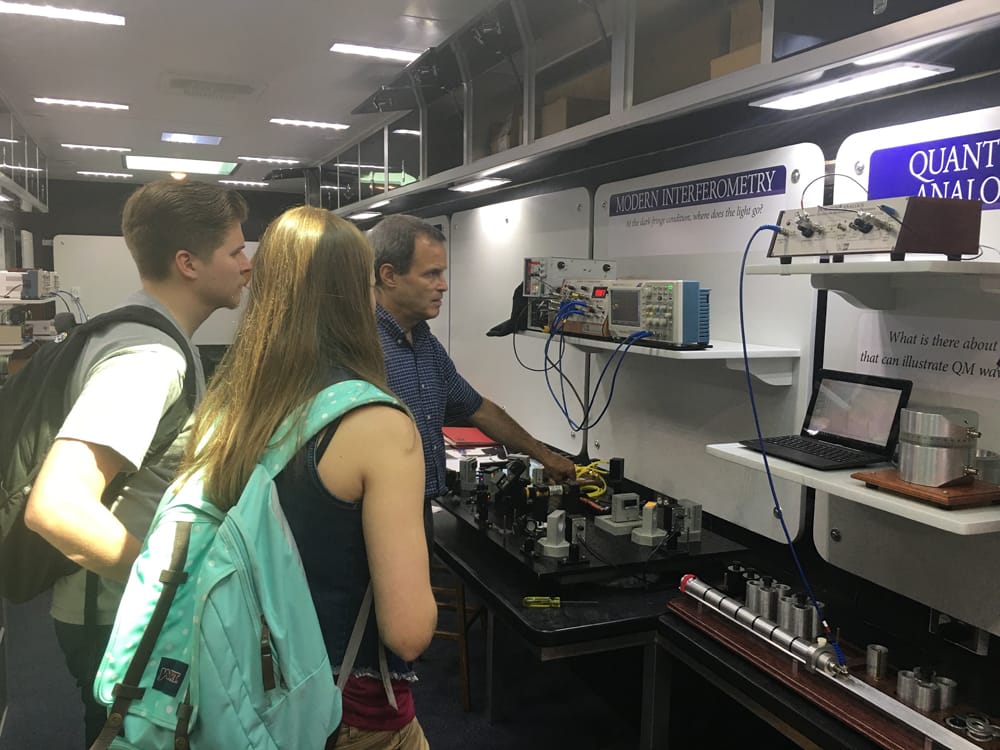
TeachSpin's “Food Truck for the Physics Mind” is a rolling laboratory, bringing to
you a hands-on encounter with some classic physics phenomena. Below we list the ‘cast
of characters':
1) Diode-Laser Spectroscopy: Tuning the interaction of laser light with atoms
2) Two-Slit Interference: A quantum ‘thought experiment' turned actual
3) Magnetic Force: Confronting the most persistent misconception in E&M
4) Optical Pumping: Enabling the radio-frequency spectroscopy of atoms
5) Quantum Analogs: The quickest way to build intuition for quantum-relevant wave
behavior
6) Modern Interferometry: Exploiting micrometer, and nanometer, sensitivity to displacement
7) Noise Fundamentals: When is electronic noise not a nuisance, but a resource?
8) Fourier Methods: What can you learn by ‘thinking in frequency space'?
9) Earth's-Field Nuclear Magnetic Resonance: The singing of the waters
10) Torsional Oscillator: Exploring damped, driven, simple harmonic motion
11) Faraday Rotation: Proving there's magnetism in the electromagnetism of light
12) Signal-Processor/Lock-In Amplifier: How to extract signals form noise
13) Magnetic Torque: The surprising results of magnetic torque vs. angular momentum
14) Nuclear Magnetic Resonance: What's the basis of the NMR technique in physics,
chemistry, and MRI?
15) Ultrasonics: What sound of MegaHertz frequencies can do for you
16) Muon Physics: Particle Physics at your fingertips, any time and any place
Dr. Ryochi Kawai
University of Alabama at Birmingham
Thursday, March 16
4:00-5:00 p.m.
MSCX -Room 114
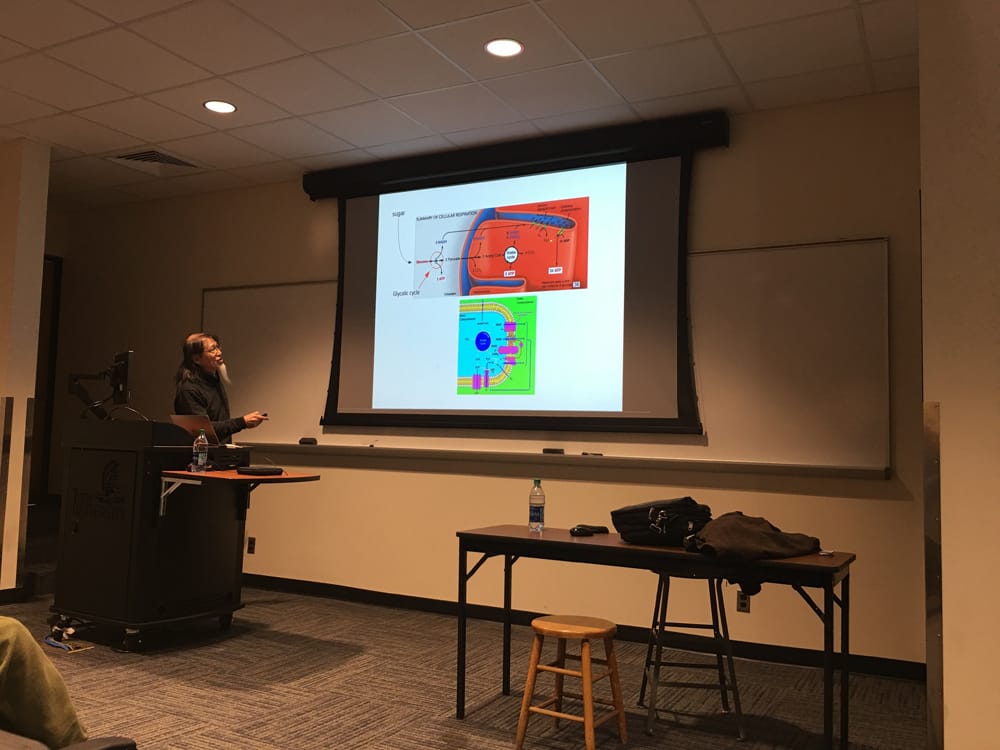
Regardless of whether they are alive or inanimate, things on the Earth are all made from molecules which are in turn made of protons, neutrons, and electrons. Then, both living and lifeless systems should obey the same laws of physics. In other words, we should be able to explain how living systems work using physics alone. However, we are not sure if the currently known laws and principles of physics are sufficient to explain the life. We are still far from being able to answer this question since we haven't explained much of the biological processes with physics yet. In order to discover a possible new physics, we need to try to explain the whole of living systems with the present physics. In this talk, I will try to introduce several interesting processes in biological cells which physicists are trying to explain using the known laws of physics, including molecular motors driven by non-equilibrium thermodynamics, photosynthesis that harvests sun light using quantum tunneling and coherence, and avian magnet compass which may be utilizing quantum entangled states. These examples, which are not fully understood yet, show that the life perhaps knows graduate level physics or above.
Dr. Kaloyan Penev
Princeton University
Tuesday, February 28
10:00-11:00 a.m.
MSCX -Room 114

I will review the importance of tidal dissipation in low mass stars and giant planets. I will present the current challenges in understanding or describing the dissipative processes involved, and present promising new results pointing to a resolution if this decades old problem. I will conclude with discussing some of the projects I would like to pursue that will be enabled by better understanding of tidal dissipation.
Dr. David King
Monday, February 27
4:00-5:00 p.m.
MSCX -Room 114
About 84 million years ago, central Alabama was situated at the shoreline of the northern Gulf of Mexico. A warm, equitable climate prevailed and the age of dinosaurs was in full swing. A small asteroid perhaps 300 to 350 m in diameter penetrated the atmosphere and shallow ocean waters of central Alabama and detonated nearly a kilometer into the crust. The rim and floor of this impact crater have stood the test of time and are still present today as an area of highly disturbed geology in Elmore County, less than 20 minutes drive from downtown Montgomery. The crater is asymmetrical and is horseshoe-shaped, ranging in size from 4.5 to 7.6 km across. Suggestions that this unusual structure might be an impact crater began in the 1970s following a state survey mapping campaign in the area. However, proof of impact in the form of shocked minerals and traces of cosmic elements like iridium was lacking until a core-drilling campaign was undertaken in 1998, which was led by me. In 1999-2000 we documented unequivocal evidence of shocked mineral grains (quartz) and traces of cosmic elements from the impactor (iridium, plus Cr, Co, and Ni). This resulted in a 2002 paper in Earth and Planetary Science Letters that laid out the evidence and thus established Wetumpka as a bona fide impact crater within in the impact-crater community. Further research has established the role of sea water in the crater modification process. We have subsequently documented evidence of aqueous mass movements and muddy tsunami flows in the crater and vicinity.
Dr. Daniel Majaess
Tuesday, January 31st
4:15-5:00 p.m.
MSCX -Room 114
Dr. Dan Majaess graduated with a Ph.D. in astronomy from Saint Mary's University in Halifax, Canada.
His primary area of research is to establish a reliable distance scale that is crucial
for determining the expansion rate of the Universe, the age of the Universe, and facilitating
efforts to delineate the spiral structure of our Milky Way galaxy. Dan is a candidate
for the position of Assistant Professor of Astronomy at Troy University.
Dr. Govind Menon
Tuesday, October 25th
6:00-7:00 p.m.
Kiwanis Club
Dr. James Sanders and Ty Naquin help demonstrate how an interferometer works at the Kiwanis Club during the talk
on gravitational waves
Dr. Govind Menon
Thursday, November 17th
4:00-5:00 p.m.
MSCX - Room 114
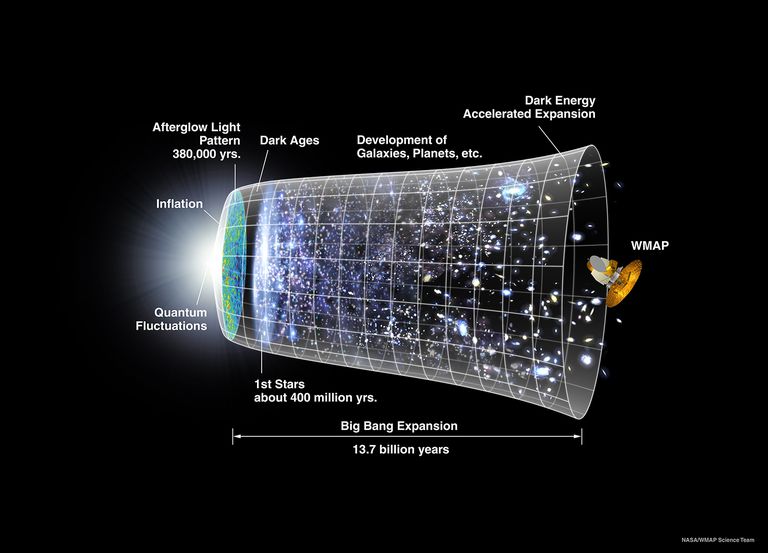
This introductory talk covers the rough cosmological history of the last 13.4 billion years of the universe.
2014-2015
Dr. Luther Beegle
October 16th, 2014
3:00-4:00 p.m.
MSCX – Room 114
Abstract: The Scanning Habitable Environments with Raman & Luminescence for Organics
& Chemicals (SHERLOC) investigation was recently selected for the Mars 2020 integrated
payload. The Mars 2020 rover has two main objectives: In Situ Analysis of samples
to determine the geological, chemical and potential for biology in a sample and 2)
To collect and cache samples of high scientific interest to return to earth for analysis
in a terrestrial laboratory. SHERLOC enables non-contact, spatially resolved, and
highly sensitivity detection and characterization of organics and minerals in the
Martian surface and near subsurface. SHERLOC is an arm-mounted, Deep UV (DUV) resonance
Raman and fluorescence spectrometer utilizing a 248.6-nm DUV laser which induces fluorescence
in aromatic organic molecules present in a sample . SHERLOC's deep UV resonance Raman
enables detection and classification of aromatic and aliphatic organics with sensitivities
of 10^-2 to below 10^-4 w/w at greater than 50 µm spatial scales. In addition to organics,
the deep UV Raman enables detection and classification of minerals relevant to aqueous
chemistry with grain sizes below 20 µm grains. The instrument goals are to assess
past aqueous history, detect the presence and preservation of potential biosignatures,
and to support selection of return samples. To do this, SHERLOC will measure CHNOPS-containing
mineralogy, measure the distribution and type of organics preserved at the surface,
and correlate them to textural features.
Brenda Marshall
Wednesday, April 8th
3:00-4:00 p.m., including Q&A
MSCX – Room 116
This talk illustrates capabilities in Mathematica 10 and other Wolfram technologies
that are directly applicable for use in teaching and research on campus. Topics of
these technical talks include: • Enter calculations in everyday English, or using
the flexible Wolfram Language • Visualize data, functions, surfaces, and more in 2D
or 3D • Store and share documents locally or in the Wolfram Cloud • Use the Predictive
Interface to get suggestions for the next useful calculation or function options •
Access trillions of bits of on-demand data • Use semantic import to enrich your data
using Wolfram curated data • Easily turn static examples into mouse-driven, dynamic
applications • Access 10,000 free course-ready applications • Utilize the Wolfram
Language's wide scope of built-in functions, or create your own • Get deep support
for specialized areas including machine learning, time series, image processing, parallelization,
and control systems, with no add-ons required